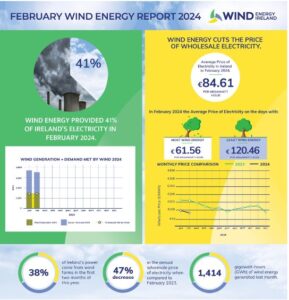Archiwum dla miesiąca: March 2024
Wind Energy and Rural Communities
Wind energy can provide a breath of fresh air for communities,says Caroline Nolan, Bainisteoir/Manager of Comharchumann Forbartha Mhúscraí, a community development organisation
based in Ballingeary
As the winds of change sweep across the Cork/Kerry border, our villages and communities stand at the forefront of a renewable revolution.
Within the very near future, this area will have the capacity to produce enough electricity to supply more than 50% of all the homes in County Cork.
This power will come from the ten existing windfarms, and four new windfarms in the planning process which, when combined, will bring the total capacity to an estimated 650MW.
This is good news for the city and county of Cork, but it leaves us with little more than a passing breeze.
While wind farms symbolise a global shift towards clean energy, the impact is felt most directly in rural areas, and yet we are overlooked in the in adoption of wind technology.
The villages most affected are in the Múscraí (Muskerry) Gaeltacht, and include Baile Mhúirne, Béal Átha an Ghaorthaidh, Cill na Martra, Cúil Aodha and Réidh na nDoirí as well as the surrounding areas that include Kilgarvan and up towards Clondrohid.
The windfarms are having a significant impact on the physical environment, but are the structures in place to have a significant impact on helping sustain rural Ireland?
It is true that most people think that local communities are either for or against windmills, and there was a mindset that believed that rural communities ‘needed to be managed’ in areas where windfarms were going to be located.
The introduction of community benefit funds as goodwill gestures and/or as conditions of funding, was one way to appease local communities.
Offering payments to landowners closest to theturbines was also another way to gain support.
The introduction of the Rewnewable Electricity Support Schemes (RESS)in 2021, now mandates that all projects under this new scheme must create a Community Benefit Fund.
There is also the aspiration that local people should be involved in the decision-making process around the allocation of the community fund, and examples of thetypes of projects that would be expected to be supported when these funds become operational include: home and community hall retrofits, pollinator farms, cycling paths, educational materials and scholarships, and
sports clubs activities.
Without a doubt, these types of projects will be welcomed and will help local communities, but is this approach going to transform ourarea?
There is real potential for local rural areas to become the drivers of positive change.
More innovative projects and partnerships need to be developed using advances in technology. This will require leadership from our council, energy providers, and local universities.
Pilot projects such as the Energy Cloud in Dublin are testing how to harness the power that ‘gets dumped’ at night so that it can be used instead to heatwater in immersion tanks overnight.
It is possible to predict that there will be other smart grid solutions, but these solutions and pilot projects need to be initiated here, within the communities most impacted by the developments.
This type of engagement would bring lasting change to our area, building capacity and know-how, providing active solutions to climate change.
For instance, it is well known that rural communities are more reliant on cars, and do not have adequate public transport. It is possible to imagine thatmeals on wheels vans, the local post van and school buses could have smart grid solutions.
The need to link rural communities into the ‘bigger conversations’ is more relevant than ever, with climate action plans being introduced in all council areas.
The approach of providing a community fund to carry out some local projects is a lost opportunity.
Rural communities, are being depopulated and are struggling to maintain services. We cannot wait for the trickle-down effect of technology to impact our areas. We need to be at the forefront of finding workable solutions, becoming the demonstration sites and fostering genuine collaboration and partnerships so there is clear engagement in the energy transition
Source: The Echo 09/3/2024
Build Our Grid – take action now
Can you act now to help accelerate the development of renewable energy?
Click the above link to email your TD
The first step to build a wind or solar farm is to get planning permission. Once you have planning permission, the project can then look to apply for a connection to the electricity grid.
The challenge is that a project can only apply for a connection to the electricity grid during a single annual application window.
If you get planning permission from An Bord Pleanála too late and miss the window, you have to wait nearly a full year before you can apply again. More time lost, more carbon emitted and more imported fossil fuels in our system.
Right now, the electricity regulator is considering running two annual application windows. This would be a significant improvement and would give wind and solar farms two chances to get their grid connection every year, helping to accelerate the development of renewable energy.

